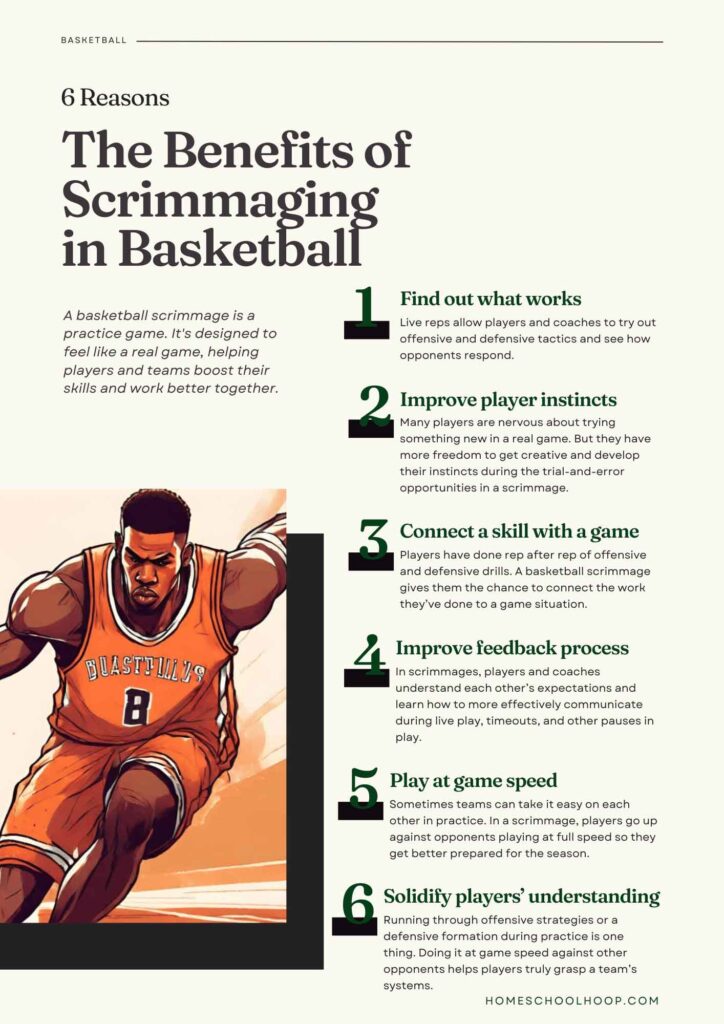Basketball scrimmages are a valuable part of training, used by teams from high school squads to top professional leagues.
NBA legend Kobe Bryant once said, “If your job is to try to be the best basketball player you can be. To do that you have to practice, you have to train.” This perfectly sums up the goal of a basketball scrimmage: it’s a practice match focused on improving players’ abilities and teamwork.
Key Takeaways:
- A basketball scrimmage is a practice game. It’s designed to feel like a real game, helping players and teams boost their skills and work better together.
- Teams hold scrimmages to practice their game plans, work on team coordination, and check out how players perform in a setting that’s like a real game.
- These practice games are great for players to learn and grow. They provide a chance to try new moves, plays, and strategies in a less pressured environment than official games.
In this article, we’ll dive into what a scrimmage in basketball involves, its purpose, how it’s usually organized, and why it’s important for the development of both young and professional players.
Basics of a Basketball Scrimmage
A basketball scrimmage is a practice game where players experience game-like conditions without the full pressure of an official match.
Scrimmages play a valuable role in preparing players and a team for the regular season. While individual drills and half-court sets are essential, scrimmages allow players to put into practice the skills and sets they’ve learned in a full-game setting.
Defining a Scrimmage in Basketball: More Than Just a Practice Game
Scrimmages in basketball are set up to mimic a real game, with two teams playing against each other. In nearly every case, they also consist of referees to call the game, and often staff to keep score and operate a clock.
What’s different?
The game’s results don’t count towards any team’s record or league or tournament standings. Player stats like points per game, assists, and rebounds are not officially recorded.
This setup allows players to master their team’s offensive and defensive schemes, and try out new strategies and skills in a realistic setting.
Two Types of Scrimmages
In basketball, scrimmages come in two main types: intersquad and opposing team scrimmages.

Intrasquad Scrimmages
Intrasquad scrimmages involve players from the same team splitting into two groups to play against each other. It’s like a mock game within the team.
Advantages:
- Safe environment: It’s a comfortable setting for trying new strategies or positions without the pressure of performing in front of an external opponent.
- Familiarity: Players get to practice against teammates they know well, which can help in understanding each other’s playing styles.
- Team building: Helps in strengthening team bonds and improves communication among players.
Opposing Team Scrimmages
These scrimmages are set up against a different team. It feels more like an actual competitive match with external players.
Advantages:
- New challenges: Facing a different team brings new playing styles and strategies, offering a broader learning experience.
- Real-game feel: It more closely mimics an actual competitive match, providing a better gauge of the team’s readiness for the season.
- Encourages adaptability: They encourage players and coaches to handle unexpected situations, improving their ability to adapt during real games.
Benefits of Scrimmage in Basketball Training
During scrimmages, coaches can see the real progress of their players and how they respond to game situations. They’re able to apply coaching techniques and tactics in a game situation and give immediate feedback.
Scrimmages can also be where teams start to get on the court, as players learn to read each other’s movements and coordinate their actions. Scrimmages can also boost players’ confidence and decision-making skills under game-like pressure.
Here are 6 reasons why basketball coaches should consider organizing scrimmages for their team:
- Find out what works and what doesn’t: Live reps allow players and coaches to try out offensive and defensive tactics and see how opponents respond.
- Improve player instincts and creativity: Many players are nervous about trying something new in a real game. But they have more freedom to get creative and develop their instincts during the trial-and-error opportunities in a scrimmage.
- Connect a skill with situational game opportunity: Players have done rep after rep of offensive and defensive drills. A basketball scrimmage gives them the chance to connect the work they’ve done to a game situation.
- Improve the feedback process: In scrimmages, players and coaches understand each other’s expectations and learn how to more effectively communicate during live play, timeouts, and other pauses in play.
- Translate skills to game speed: Sometimes teams can take it easy on each other in practice. In a scrimmage, players go up against opponents playing at full speed so they get better prepared for the season.
- Solidify players’ understanding of the system: Running through offensive strategies or a defensive formation during practice is one thing. Doing it at game speed against other opponents helps players truly grasp a team’s systems.

How to Organize a Quality Basketball Scrimmage
Organizing a quality basketball scrimmage means careful planning to create a game-like setting. The aim is to make it as close to a real game as possible, so players can practice effectively.
Here are 10 tips for setting up an effective basketball scrimmage:
- Schedule Scrimmages Before Official Games: Plan scrimmages after you’ve been practicing for weeks and just before the season starts. This helps players get into the rhythm of real games.
- Scrimmage Against Another Squad: If possible, scrimmage against a different team. This brings new challenges and learning opportunities.
- Play 5-on-5 with Regular Rules: Use standard game rules. This keeps the scrimmage realistic and helps players adjust to official game conditions.
- Have Staff to Keep Score and Run the Clock: Just like in real games, have someone keep score and manage the clock. This ups the competition and adds to the scrimmage’s authenticity.
- Hire Referees: If feasible, bring in professional referees. They help players adapt to official calls and get better at avoiding fouls like hand-checking and violations like traveling.
- Use Your Pre-Game Routine: Start with your regular pre-game meetings and warm-up. It sets the tone and gets players familiar with the routine of gameday.
- Scrimmage in Game-Length Periods: Match the duration of a real game. This tests players’ endurance and gets them comfortable competing in quarters or halves.
- Get Everyone in the Scrimmage: Rotate all players. This gives everyone experience and helps find the best team dynamics.
- Schedule Post-Game Practice Situations: After the official scrimmage, work on specific offensive or defensive setups. This could be out-of-bounds plays or even high-pressure final-minute situations.
- Film the Scrimmage: Record the scrimmage. Watching it later is a great way to analyze players, and plays, and improve strategies.
FAQs
What does a scrimmage mean in basketball?
A basketball scrimmage is a practice game. It’s set up like a real game but is used for training purposes. Players can practice game situations, strategies, and teamwork without the pressure of an official game’s outcome.
What is the difference between a game and a scrimmage?
The main difference is the stakes. A game is official and counts towards a team’s record or standing in a league or tournament. A scrimmage, on the other hand, is practice. It’s used for training and doesn’t affect a team’s official record.
What is the point of a scrimmage game?
The point of a scrimmage in basketball is to provide players with a game simulation experience in a practice setting. It’s a valuable tool for learning and development without the pressure of an official game.
Does scrimmaging count as a game?
No, scrimmaging doesn’t count as an official game. Scrimmages are practice and used for player evaluation, training, and skill development.

